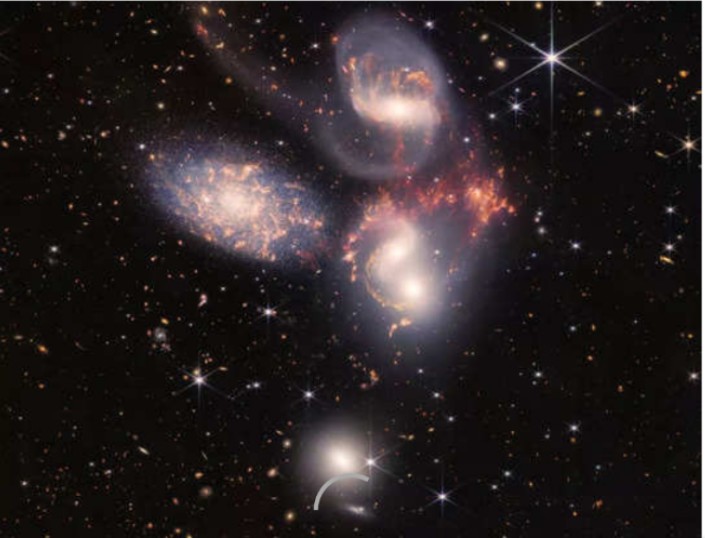Webb Telescope President Joe Biden and NASA released the clearest-ever image of our young Universe, dating to the time soon after the Big Bang.

The United States space research agency NASA said in a release on Monday (July 11) that its James Webb Space Telescope (JWST) has produced the deepest and sharpest infrared image of the distant universe that has ever been seen, heralding a major event in astronomy. The JWST is the largest and most powerful telescope ever built.Webb Telescope
Thousands of galaxies — including the faintest objects ever observed in the infrared — have appeared in Webb’s view for the first time, all captured in a relatively small area. “This slice of the vast universe covers a patch of sky approximately the size of a grain of sand held at arm’s length by someone on the ground,” the release said.Webb Telescope
US President Joe Biden unveiled the image at the White House, and said: “This is the oldest documented light in the history of the universe from 13 billion — let me say that again, 13 billion — years ago… We can see possibilities no one has ever seen before… “We can go places no one has ever gone before.”
The image released is billed as a “preview”, and the other set of images will be released at 10.30 am Tuesday, Eastern Time (ET) or at 8 pm Tuesday, Indian Standard Time (IST) on NASA’s website (http://www.nasa.gov/webbfirstimages) and social media accounts. Here’s what has been found so far.
What can be seen in the image James Webb Space Telescope?
Calling it “Webb’s First Deep Field”, NASA said the image shows galaxies that were once invisible to us. The image shows shining objects packed together in hues of blue and orange. Swirling, faraway galaxies — similar to how the Milky Way looks — are also visible.
Light travels at 186,000 miles per second. And that light that you are seeing on one of those little specks has been travelling for over 13 billion years,” NASA administrator Bill Nelson said of the image, the BBC reported.
And by the way, we’re going back further, because this is just the first image. They’re going back about 13 and a half billion years. And since we know the Universe is 13.8 billion years old, you’re going back almost to the beginning,” he added.
Taken by Webb’s Near-Infrared Camera (NIRCam), the image was made by combining various images at different wavelengths. The image shows the galaxy cluster called SMACS 0723, as it appeared 4.6 billion years ago.
What is NASA’s James Webb Telescope?
The telescope has been in the works for years. NASA led its development with the European Space Agency (ESA) and the Canadian Space Agency. It was launched aboard a rocket on December 25, 2021, and is currently at a point in space known as the Sun-Earth L2 Lagrange point, approximately 1.5 million km beyond Earth’s orbit around the Sun.
Lagrange Point 2 is one of the five points in the orbital plane of the Earth-Sun system. Named after Italian-French mathematician Josephy-Louis Lagrange, the points are in any revolving two-body system like Earth and Sun, marking where the gravitational forces of the two large bodies cancel each other out. Objects placed at these positions are relatively stable and require minimal external energy or fuel to keep themselves there, and so many instruments are positioned here.
L2 is a position directly behind Earth in the line joining the Sun and the Earth. It would be shielded from the Sun by the Earth as it goes around the Sun, in sync with the Earth.
What is the mission of the James Webb Space Telescope?
NASA says the James Webb Space Telescope will be “a giant leap forward in our quest to understand the Universe and our origins”, as it will examine every phase of cosmic history: from the Big Bang to the formation of galaxies, stars, and planets to the evolution of our own Solar System.
The science goals for the Webb can be grouped into four themes. The first is to look back around 13.5 billion years to see the first stars and galaxies forming out of the darkness of the early universe. Second, to compare the faintest, earliest galaxies to today’s grand spirals and understand how galaxies assemble over billions of years. Third, to see where stars and planetary systems are being born. And fourth, to observe the atmospheres of extrasolar planets (beyond our solar system), and perhaps find the building blocks of life elsewhere in the universe. The telescope will also study objects within our own Solar System.
http://www.nasa.gov/webbfirstimages
The JWST will be able to see right through and into massive clouds of dust that are opaque to earlier generation visible-light observatories like the Hubble Telescope. Another difference is that the Webb is equipped with cameras and other instruments sensitive to infrared or “heat” radiation, and the Hubble is not. The expansion of the universe causes the light that would normally be in wavelengths that are visible to be shifted to longer infrared wavelengths, normally invisible to human eyes, The New York Times said in a report.




